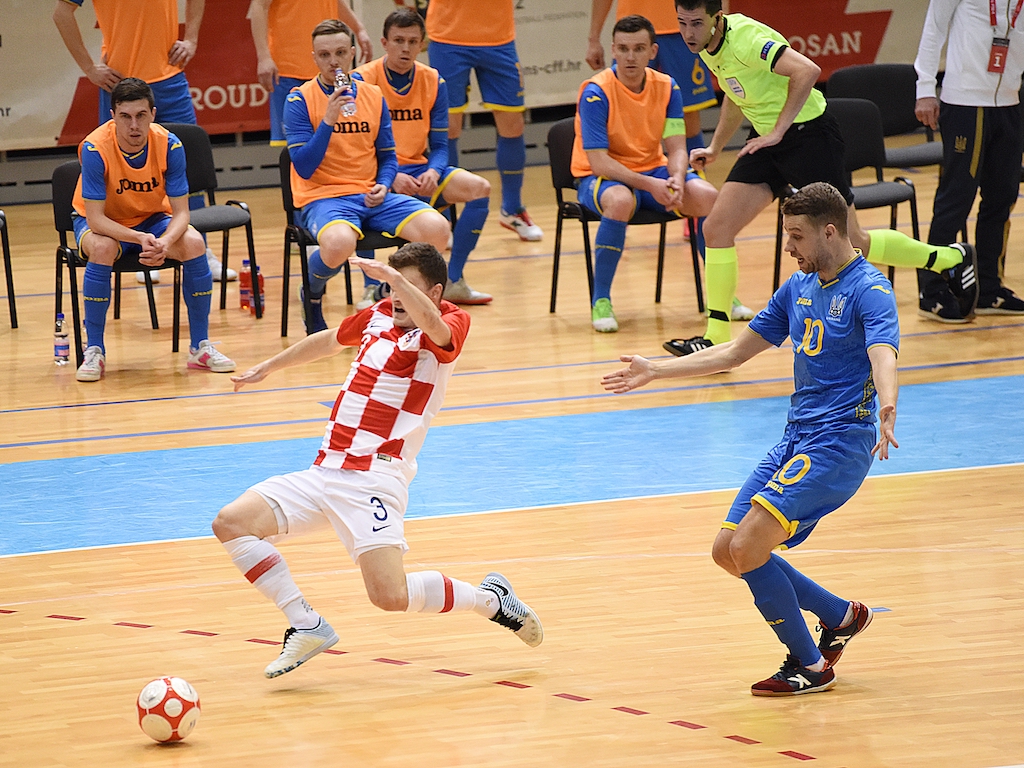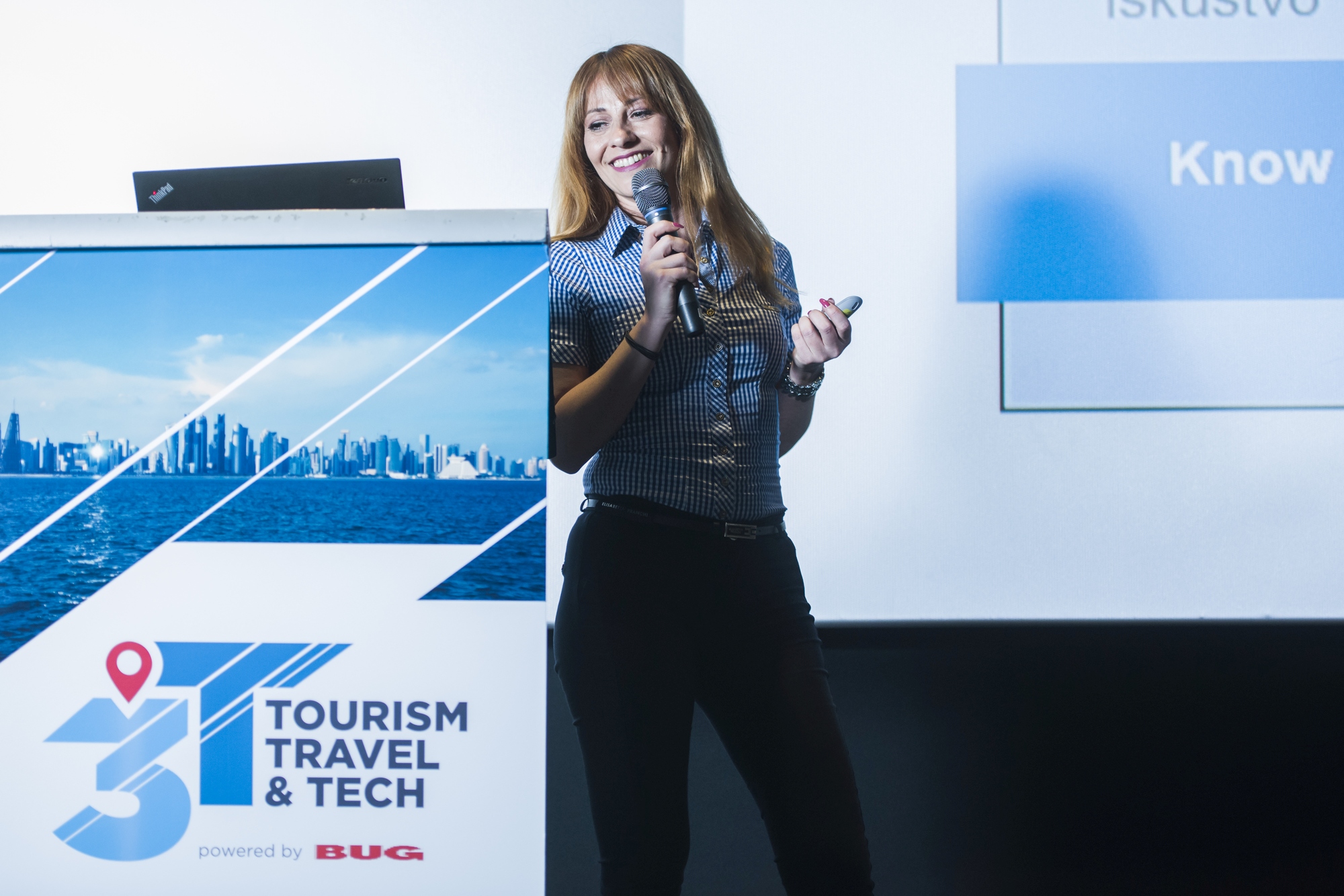Croatia Futsal Team Tops Ukraine, One Step Closer to Euros
March 4, 2021 - The Croatia futsal team recorded its third victory in the European Championship qualifiers in an excellent match against Ukraine in Osijek on Wednesday.
After the successful opening of the European Championship qualification cycle in 2022, with victories against Albania and Denmark, Marinko Mavrović's Croatia welcomed the main competitor for first place, the national team of Ukraine.
The match in Osijek could not have started better for Croatia: in the second minute, Suton finished a quick action for the lead. However, Pedias scored in the ninth minute from a distance to equalize, and shortly before the half, Malyshko beat Luketin for the Ukraine lead (2:1).
Slobodan Kadic
That result stood on the scoreboard until the last five minutes of the game. Perić first assisted Jelovčić for 2:2, and then they switched roles - Jelovčić served Perić, who hit the back of the net for the Croatia victory (3:2).
Slobodan Kadic
"Well done to the boys; we kept a high rhythm and pressure; it was not easy to play against them," coach Mavrović told HNTV.
"We have a good atmosphere in the team. Everyone gave a lot to this victory. This victory brought us very close to the European Championships; we did what we wanted," added the coach after his third appearance on the Croatia bench and the third victory.
Croatia now leads the table with nine points, Ukraine and Denmark have three points each, but one match less, while Albania is at the bottom without points.
A spot at the 2022 European Championships in the Netherlands will be won by the winners of eight groups and the six best second-placed teams.
The two weakest second-placed national teams will fight for a spot as well.
In the second match of Group 1, Denmark won in Albania 3:1.
Croatia will play against Ukraine again on Sunday, March 7, this time in Zaporizhia.
Futsal EURO Qualifiers, Group 1:
1. Croatia 9 (3)
2. Ukraine 3 (2)
3. Denmark 3 (2)
4. Albania 0 (3)
Source: HNS
To read more about sport in Croatia, follow TCN's dedicated page.
Winter Transfer Window Success: Hajduk Jumps to 2nd in HNL Player Value
March 4, 2021 - Hajduk jumps to 2nd in HNL player value thanks to an impressive winter transfer window that brought in Lovre Kalinić, Marco Fossati, Marko Livaja, and Alexander Kačaniklić.
Slobodna Dalmacija reports that after the winter transfer window, Hajduk is again the second HNL team in player value.
Only two months ago, due to the disastrous summer and autumn, the club's value, according to Transfermarkt, dropped to EUR 20.5 million, which placed it only fourth in the league standings, even behind Rijeka (24.2) and Osijek (20.9). As the results fell, so did the value of Hajduk's players.
However, the market activity during the winter and bringing in players like Lovre Kalinić and Marko Livaja certainly enhanced the club, thus bringing it a new value.
First, the President of the Management Board, Lukša Jakobušić, brought back goalkeeper Kalinić on loan from Aston Villa in December (until the end of June this year). Then, Hajduk's sports director Mindaugas Nikoličius showed his worth, bringing in the brilliant Marko Livaja, who had terminated his contract with AEK Athens, and Swedish winger Alexander Kačaniklić, who once played in England for Fulham and the French Ligue 1.
Midfielder Marco Fossati completed the quartet of experienced players who strengthened Hajduk this winter, arriving on loan from the Italian second league club Monza.
Including the departures of Gyurcso, Ljubić, Delić, and Radić, who also have a certain price, Hajduk became richer by almost five million euro compared to December last year (25.3).
Osijek is close to EUR 24.8, and Rijeka is not far from EUR 23.8. At the top, of course, is Dinamo with EUR 103.3 million, which is more than Hajduk, Osijek, Rijeka, and even Gorica (19.4) combined.
The HNL table confirms that these numbers are not necessarily a guarantee of success, as Osijek is practically equal to Dinamo, Gorica is third, and Hajduk is fifth.
At EUR 3 million, Livaja is the most expensive of Hajduk's new players. Only Mijo Caktaš (3.7) has a higher price than him. Kalinić is worth EUR 2.8 million, Kačaniklić EUR 1.2 million, and Fossati EUR 400,000.
Not only did they raise the value on paper, but these players also left an excellent first impression. This is especially true of Kalinić, who came first. His presence has a calming effect on the rest of the team, and last week his heroics saved Hajduk's victory against Rijeka, defending Andrijašević's penalty in the final seconds of the match.
In any case, Hajduk succeeded in the transfer window, perhaps even better than the fans expected. The first impressions are positive, the value of the team has grown, and now it must only be translated into results on the pitch.
HNL Clubs in millions (compared with Decemberr 2020)
1. Dinamo 103.3 (+2.7)
2. Hajduk 125.3 (+4.8)
3. Osijek 124.8 (+3.9)
4. Rijeka 123.8 (-0.4)
5. Gorica 119.4 (-0.9)
6. Lokomotiva 113.8 (-0.9)
7. Istra 1961 119.8 (+3.2)
8. Varaždin 118.0 (-0.9)
9. Slaven Belupo 117.8 (+0.6)
10. Šibenik 117.5 (+0.5)
11. Total 243.5 (+12.6)
To read more about sport in Croatia, follow TCN's dedicated page.
Protected Croatian Products Safe from Grey Economy with Higher Prices
March the 4th, 2021 - Protected Croatian products are worth paying that bit more for, and the public are growing more and more aware of the need to fork out a few kuna more in order to keep such products protected from the clutches of the grey economy.
As Poslovni Dnevnik/Marta Duic writes, this year, more precisely until the end of February, three new names of protected Croatian products were registered at the level of the European Union - Rudarska greblica, Dalmatinska pecenica and Dalmatinska panceta.
Thus, Croatia, as the youngest member state of the EU, is in ninth place in terms of the number of registered names of domestic agricultural and food products, and the first on the list of protected Croatian products to receive the label was Krk´s much loved prosciutto. How much this label helps when it comes to actual product placement and the penetration of foreign markets was discovered by the manufacturers themselves.
"We also have an additional fifteen products that we´ve protected at the national level and are in preparation for the procedure or are already in the process of registration at the EU level, and six more products for which the national protection procedure is underway.
By protecting the name, manufacturers protect the reputation of their product from misuse and damage, and it is this sign that guarantees the consumer the purchase of an authentic and controlled product which boasts proper recognised quality and is of local origin. The recognisability of a product is connected with the recognisability of the area where it is produced, which contributes to the strengthening of the tourist offer, but also to the sustainable development of rural areas.
The importance of registration and protection also lies in the fact that it ensures classification into a higher price category, which for the manufacturer means better market positioning and of course - higher income.
According to the European Commission (EC), these products fetch an average of 2.3 times more in terms of price than a similar unlabelled product, and according to a survey conducted by the ministry on more than fifty certified manufacturers, as many as 68 percent of manufacturers have noticed an increase in demand for their product since they have become proud bearers of such a label,¨ they point out from the Ministry of Agriculture.
Ante Madir, executive director of the Croatian Prosciutto Cluster, explained that precisely because of the sensory properties and specific traditional production technology, Croatian prosciutto has a great export potential and potential for placement via tourism through the country´s already very rich gastronomic offer.
As he says, through the Croatian Prosciutto Cluster and various prosciutto associations, they promote these protected Croatian products, every year in another city they organise Croatian Prosciutto Days focused exclusively on protected prosciutto, and representatives of the Cluster participate in all specialised fairs across the country and abroad.
"EU labels of protected geographical origin, which are carried by Krk, Drnis and Dalmatian prosciutto, and the label of originality boasted by Istrian prosciutto, are a guarantee of quality and are increasingly recognised by local customers. Foreign tourists have long been aware of what is involved when it comes to such labels, they know the difference and always put quality before price.
Designations of protected geographical origin and originality are important not only for their recognisability, but they also have the function of protection against the clutches of the grey market. Here in Croatia, the production of prosciutto is growing from year to year, but this is not enough to cover its consumption.
Specifically, we eat about a million pieces of prosciutto a year, and we produce about 450,000 pieces of it. The growth of production was not stopped by the coronavirus pandemic, but, unfortunately, it slowed things down in terms of placement. Tourism suffered because of the pandemic, and tourism is otherwise the best opportunity for the placement of Croatian prosciutto caused a decline in sales.
When it comes to exports, we have a trend of increasing sales of our prosciutto in the EU. Some prosciutto companies in foreign markets had an increase in sales in 2020, regardless of the pandemic, up to even 30 percent more when compared to 2019," said Madir.
¨Croatia exports its prosciutto to all countries in the immediate region, but also to those countries where the Croatian diaspora live, such as Austria and Germany. At the end of last year, one Croatian prosciutto company exported the first quantities of prosciutto to Ukraine. We also had exports to New Zealand and Hong Kong.
Croatian prosciutto is sold in Serbia, Northern Macedonia, and Bosnia and Herzegovina. The Association of Dalmatian Prosciutto Producers prepared the documentation and applied for the tender M3.2.1-2, for support for information and promotion activities. If the funds are obtained through a tender, then we will use them for the promotion and recognition of prosciutto as a protected EU product,¨ added Madir.
One of the producers of protected Croatian prosciutto, more precisely the Dalmatian type, is Vlade Prancic, and his facility annually produces about a hundred tonnes of prosciutto. As he says, in this ongoing pandemic crisis, sales have dropped by twenty percent, but he believes that quality products always find their way to the customer, so he remains optimistic about the future.
"When it comes to protected Croatian products, local customers are increasingly aware and it is not a problem for them to spend a little more money on such products. On the other hand, buyers in foreign markets such as Germany or Austria, have long recognised the quality of protected products and this is our only chance given that the quantity Croatia has can quite simply not compete with Spanish and Italian manufacturers.
We sell our prosciutto almost 75 percent of our production through the HoReCa sector throughout Croatia, and our exports grow from year to year, so 25 percent of our total production goes off to Germany, Austria, Slovenia and the Czech Republic. Events, such as Croatian Prosciutto Day, contribute to the branding of protected Croatian products, but that is not enough.
Most producers are small family prosciutto manufacturers, they are masters of prosciutto, but not for marketing and branding, so in the promotion of protected Croatian products, we really need the help of our state institutions and continuous campaigns that would educate customers and other producers,¨ said Prancic.
According to several published studies related to various European Union trademarks, consumers are more aware of trademarks from southern Europe, and the reason for this may lie in the fact that Italy, France and Spain have around 700 protected products to boast of. The experience we have from 2020 has shown us the importance of domestic production in all segments.
For the latest travel info, bookmark our main travel info article, which is updated daily.
Read the Croatian Travel Update in your language - now available in 24 languages.
3T Conference – How will Tourism Survive after the Pandemic?
March 4, 2021 - The 3T Conference will hold its 4th edition online on March 23, 2021.
3T – Tourism Travel and Tech conference returns this year for the 4th time and will be available for everyone online. Depending on the COVID-19 measures, it may also have a location for live visitors. On March 23rd, participants will hear tourism and IT professionals who share their thoughts on how to deal with pandemic and post-pandemic tourism. The current situation with COVID-19 and travel opens up possibilities for IT and tech to support tourism activities. The main topics covered will be climate – sustainability – technology and main the conference will try to answer the main question „How to survive after the pandemic?“

The exact conference programme and all the speakers are not yet set, but two keynote speakers will share their tourism and tech thoughts. The first keynote is Zoran Pejović with the lecture “How to keep the best employees in tourism in the post-Covid world?” The second keynote is Robert Sedlar, who will analyse the pandemic's consequences on the tourism sector and offer directions for the future. Additionally, the participants will be able to hear famous Croatian chef Mate Janković and lecture on “How to be great with content and build personal branding on social media?” by Ilija Brajković.
The panel discussion with the main conference topic will be moderated by Oleg Maštruko, director of the conference. He believes there will be a lot of interest in tourism and tech-related advice. Everyone who works in tourism will need to use technology as a way out of the unprecedented crisis. The conference will try to address some of the following challenges:
Can tourism be sustainable, and how can the development of technology help us?
How to maintain the quality of life at the desired level with the growth of tourist traffic?
Will VR and AR reduce the need for physical travel to the location?
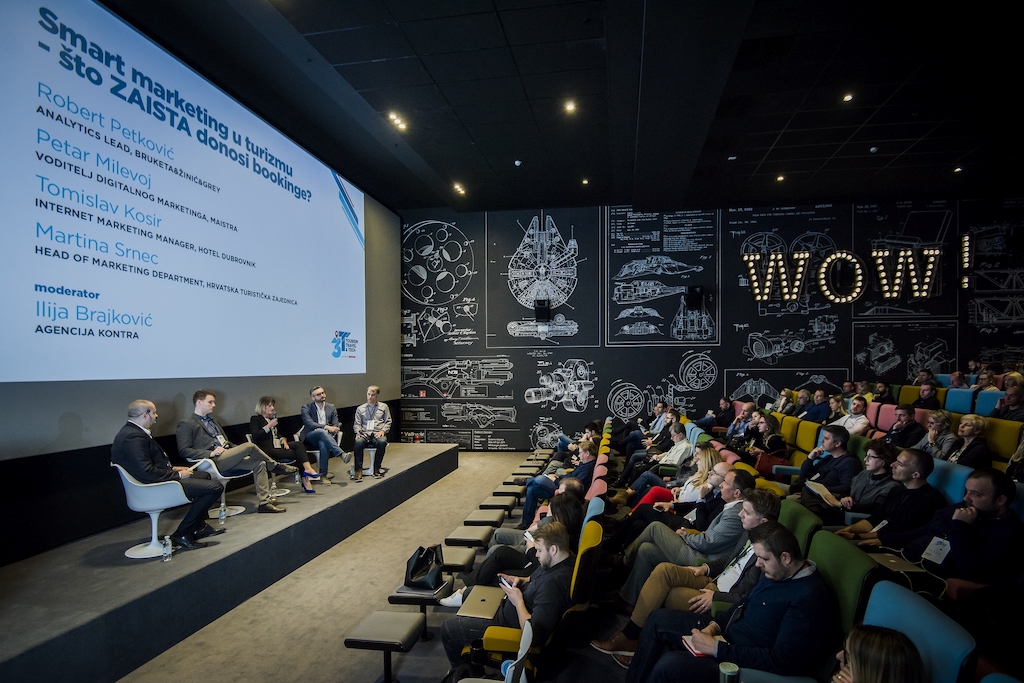
To participate and learn from experts how to deal with tourism challenges during the pandemic, check out more info on the conference and tickets at 3t.bug.hr.
For the latest travel info, bookmark our main travel info article, which is updated daily.
Read the Croatian Travel Update in your language - now available in 24 languages.
10 PHOTOS: Incredible Images of the Best Croatian Artistic Photography 2021
March 4, 2021 – Following a national competition, the Croatian Photo Association have chosen the best Croatian artistic photography of the year. 10 incredible images will now represent Croatia in the prestigious Biennial of the International Federation of Photographic Art in Paris.
Following a national competition, the Croatian Photo Association (Hrvatski Fotosavez) have chosen the best Croatian artistic photography of the year. 10 incredible images will now represent Croatia in the prestigious Biennial of the International Federation of Photographic Art (FIAP) in Paris.
The International Federation of Photographic Art (FIAP - Fédération Internationale de l'Art Photographique)
The International Federation of Photographic Art (FIAP - Fédération Internationale de l'Art Photographique) is an international organization of national associations of photography. More than 85 national associations are members, comprising nearly one million individual photographers.
FIAP was founded by M. Van de Wijer of Belgium in 1946. Its first congress took place in Bern, Switzerland in 1950. At this time, one of the national photographic associations represented was that of Yugoslavia. Following the federation's break up, each of its former republics now runs its own national photography association. Continuing a 70 year tradition, they still enter the prestigious International Federation of Photographic Art Biennial.
FIAP congresses have grown so large over the years, they are now seperated into different categories and held once every two years. Black and white and nature photography have their biennials one year, and the next year colour photography gets its biennial. The competition congress visits different countries each year. The 2021 FIAP Colour Biennial will be held in Paris, France.
The FIAP Colour Biennial competition and congress is split into two parts. The oldest, and arguably the most prestigious part of the competition, sees the best photography appearing in print and displayed individually upon the walls of the host venue. 10 examples of the best Croatian artistic photography of the year have been chosen by Hrvatski Fotosavez to represent Croatia in this section of the event.
A further 20 Croatian entries will appear in the congress's other section – projected photography. These entries are submitted digitally, rather than in print, to be shown in projection at the event.
Following a national competition, the Croatian Photo Association have chosen the best Croatian artistic photography of the year to represent Croatia in the prestigious congress and competition.
The Croatian Photo Association (Hrvatski Fotosavez)
The Croatian Photo Association (Hrvatski Fotosavez) is the legal successor of the Photographic Association of Croatia, founded on March 27, 1949 in Zagreb, and the historical successor of the Croatian Amateur Photographic Association, founded on June 11, 1939 in Zagreb. Its members are individual photography clubs and societies from all over Croatia. From their ranks, the best Croatian artistic photography of the year have been chosen.
Photography and cinema club 'Picok' from Đurđevac (Foto kino klub Picok, Đurđevac)
For the 2021 entries to the Colour Photography Biennial in Paris, special mention must be given to the remarkable achievements of one society of photographers from the town of Đurđevac. Of the 30 photographs selected to represent Croatia in this year's competition, no less than 8 of them came from members of this one photography society. In addition to Mato Zeman and Željko Car, who are interviewed below, works by Ivan Hećimović and Ivan Nemet were also selected. According to these results, Photography and cinema club 'Picok' from Đurđevac are the most successful association in this year's Croatian Photo Association competition. Coincidentally, the four Đurđevac photographers had a large joint exhibition of award-winning photographs in Đurđevac just last year. After the event, all 40 works exhibited were donated by the photographers to the city of Đurđevac. Bravo Picoki!
FIAP, Hrvatski Fotosavez and the 10 photographers chosen for 2021 FIAP Colour Biennial have kindly given Total Croatia News exclusive permission to reproduce this year's print entries. Here, we profile the best Croatian artistic photography of the year and meet the photographers.
The Best Croatian Artistic Photography 2021
Damir Rajle 'Sunshine Road'
 Croatian artistic photography by Damir Rajle
Croatian artistic photography by Damir Rajle
My name is Damir Rajle. I am semi-professional photographer from Osijek. My primary profession is cartographer and land surveyor, mostly involved in digital orthophoto and topographic maps. My photograph 'Sunshine Road' is a wine road in Baranja. I am very often in that exact place. But, that day, the setting sun was directly ahead and so I tried a couple of shots. Suddenly, a boy came along, silhouetting himself against the sunlit road. The naturally hilly landscape of the vineyard adds to the composition.
Dušan Grbac 'Žuti'
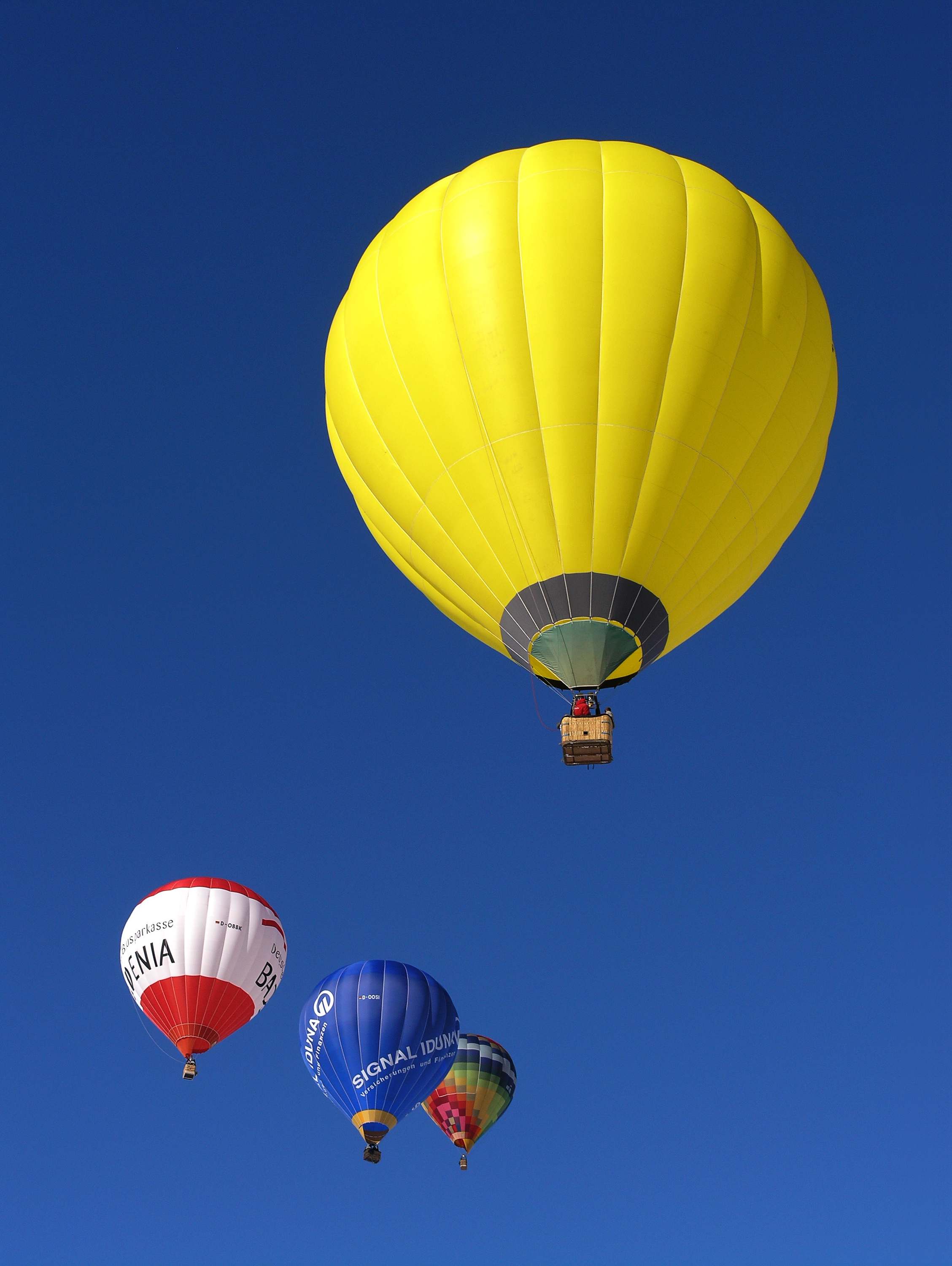 Croatian artistic photography by Dušan Grbac
Croatian artistic photography by Dušan Grbac
My name is Dušan Grbac and I was born in 1960, in Rovinj. I started shooting and developing black and white photography in 1975. I developed the photographs on my own in a small, analogue darkroom at home. In 1982 I became a member of the Photo Club Rovinj and thereafter participated in a number of exhibitions. In 2002 I embraced digital photography. I actually work as an IT specialist. In my free time, I like to engage in photography and I've held dozens of lectures and workshops about photography. I'd really like to pass on to others everything I've learned about photography over the years. 'Žuti' (Yellow) was actually taken in January 2006 in the Italian town of Dobbiaco. The annual balloon show was held at a temperature of -16 °C! This made the sky crystal blue. I couldn't resist that tonal contrast, the colours... and 'voila'.
Mirjana Spajić Buturac 'Saturn'
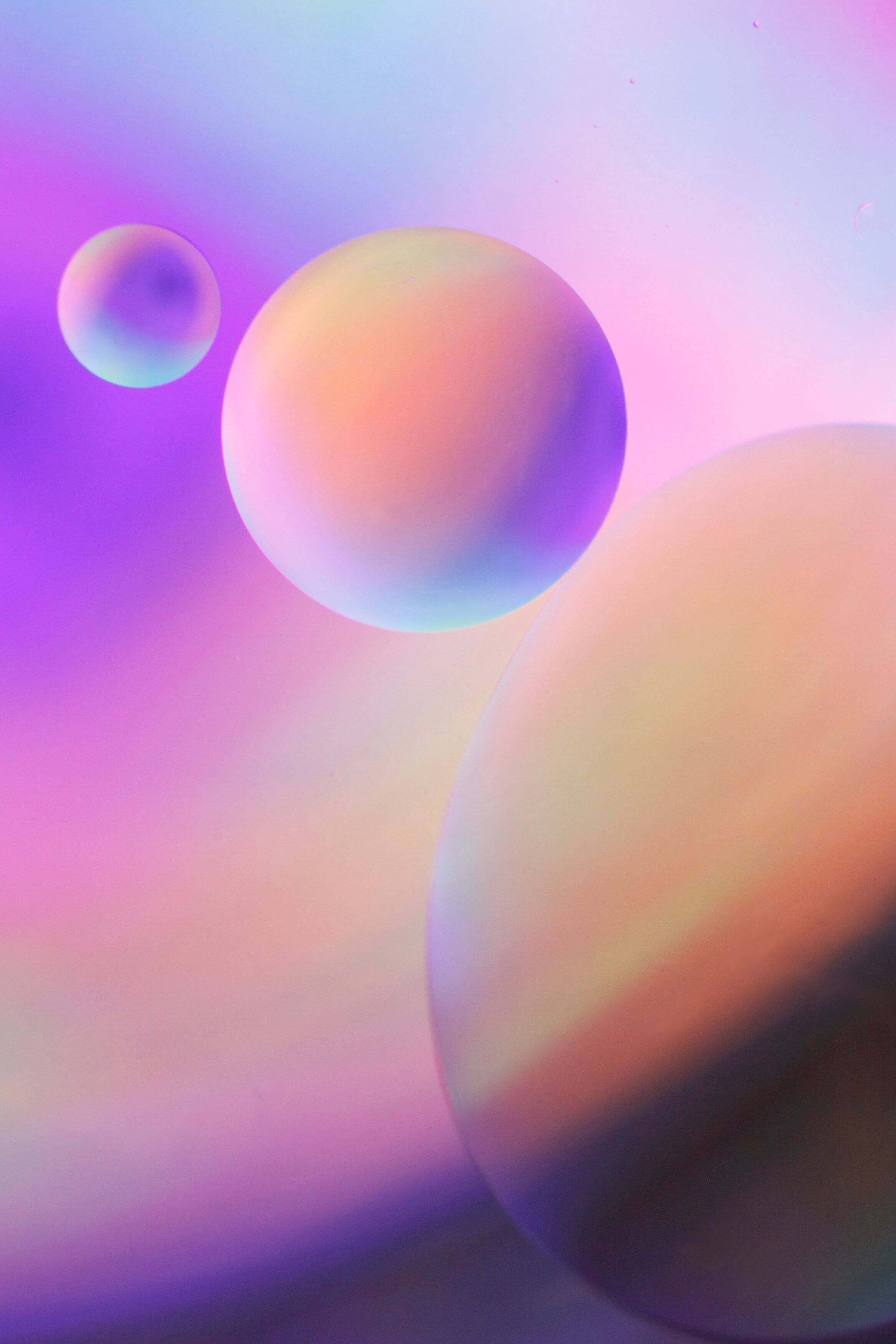 Croatian artistic photography by Mirjana Spajić Buturac
Croatian artistic photography by Mirjana Spajić Buturac
My name is Mirjana Spajić Buturac. I'm originally from Vinkovci, but I have been living in Zagreb for 20 years. I studied in Osijek and by profession, I am a professor of mathematics and informatics. I've been interested in photography since my student days. However, it was a colleague, Professor Vladimir Šimunić that truly awoke my passion for photography in me and in 2014 I certified as a photographer, enrolled in Fotoklub Zagreb and started participating in photography competitions. I took an online course at Udemy to perfected my use of Photoshop and photo processing. I work at the School of Crafts for Personal Services in Zagreb, which, among other things, has a photography major, and in addition to mathematics and computer science, I now also teach digital photography. I am so happy that photography has become a part of my job! 'Saturn' was taken in December 2020. It shows drops of olive oil in water. Under the influence of ultraviolet light and a fluorescent poster under the bowl of water, the oil droplets took on a three-dimensional effect. My seven-year-old son Leon noticed that the largest droplet had a dark ring, like Saturn. That's how the photo got its name.
Mato Zeman 'Spring Fields'
 Croatian artistic photography by Mato Zeman
Croatian artistic photography by Mato Zeman
My name is Mato Zeman and photography has been my hobby for long time. I live in Kloštar Podravski, a small village in Podravina, between the river Drava on the north and Bilogora mountain on the south. In my full0time job I worked in the 112 Emergency Centre in Koprivnica, but I've now been retired for 2 years. Photography is my hobby for a long time. I've participated in several international photo contests. In 2015, FIAP awarded me the honorary title FIAP Artist and three years later the title EFIAP (Excellence Fédération Internationale de l'Art Photographique). I am a member of the Photo and Cinema club 'Picok' in Đurđevac. I'm also a member of the local artistic association 'Kloštranska paleta' in my home village. Two of my works were selected for FIAP 2021 Biennial of Colour Photography in France and will represent my country. I am very proud of this. The one appearing in print 'Spring Fields' was taken at the fields of young corn on the slopes of Bilogora. The rows of corn are in a nice S line, the sky is partly cloudy with the sun shining through.
Nenad Martić 'Red, White and Blue 2'
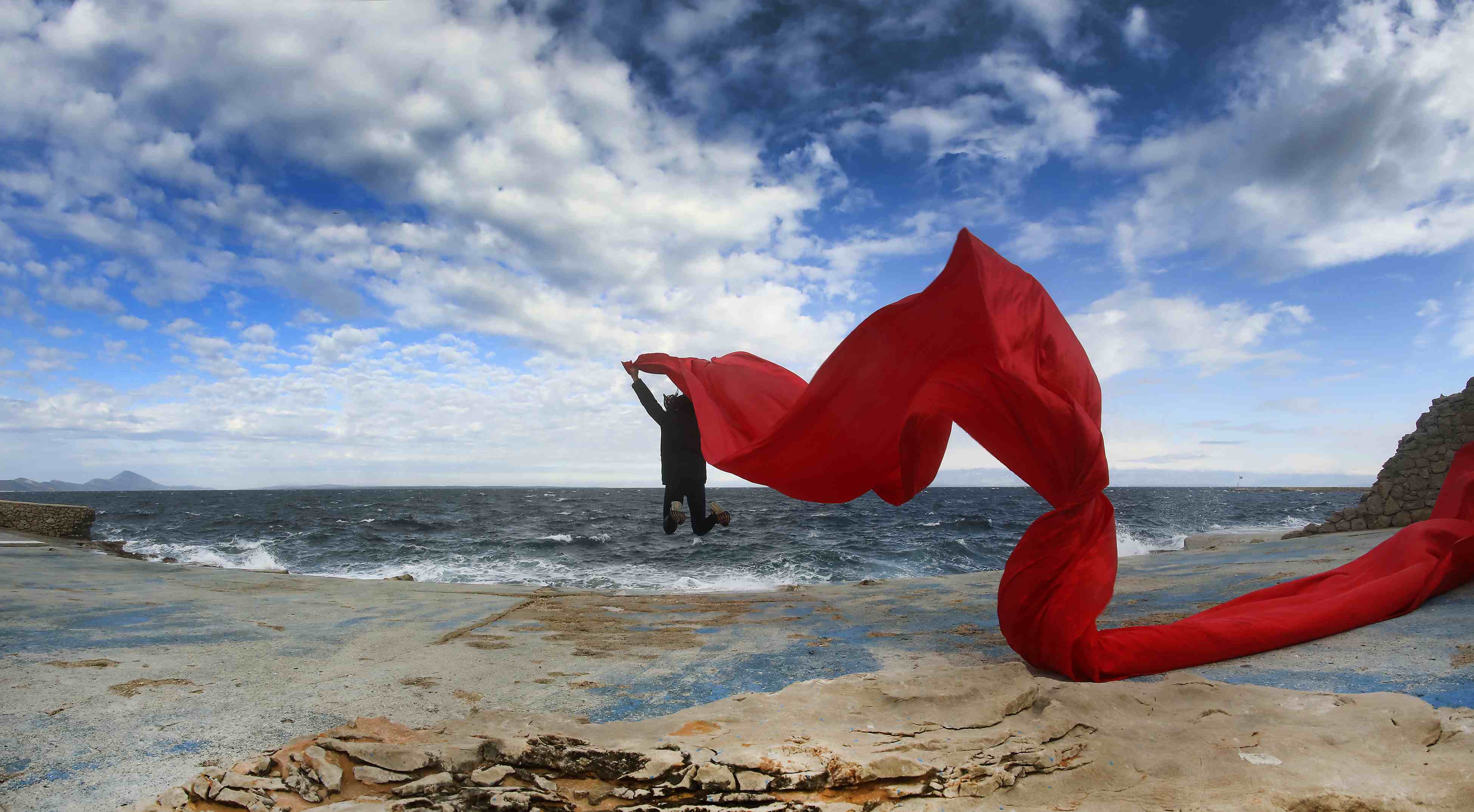 Croatian artistic photography by Nenad Martić
Croatian artistic photography by Nenad Martić
My name is Nenad Martić. I was born in 1951 in Zagreb, where I graduated from the Department of Fine Arts at the Faculty of Education, University of Zagreb.I devoted most of my professional career to graphic design and illustration, beginning in the 1980s with the Start and Svijet magazines. The second half of my career was marked by the gradual introduction of a new artistic expression; digital photography. Free of assignment of specific commissions and deadlines, artistic photography became a passion. I dedicated myself to it for the last ten years. I take different kinds of photographs, but I most prefer street photography. It's a kind of documentary photography, focusing on the nuances of human gestures and street context, capturing and conveying the moment to those who are not there. 2014 was a turning point for me because I joined Photo Club Zagreb. Thereafter, I had three solo exhibitions, was included in over a hundred group ones and won several international and national awards and nominations. These included the Ferdinand Soprano Grand Prix and the Viktor Hreljanovic Award from Photo Club Rijeka in 2019, most successful author and the most successful Croatian author at the 39th Zagreb Salona in 2020 and I won the prestigious Tošo Dabac Award 2019 for outstanding contribution to photography in Croatia. My photo 'Red, White and Blue 2' was taken on the island of Lošinj. The model is my daughter. It is one of a series of photographs taken with red cloth.
Silvija Butković 'Together'
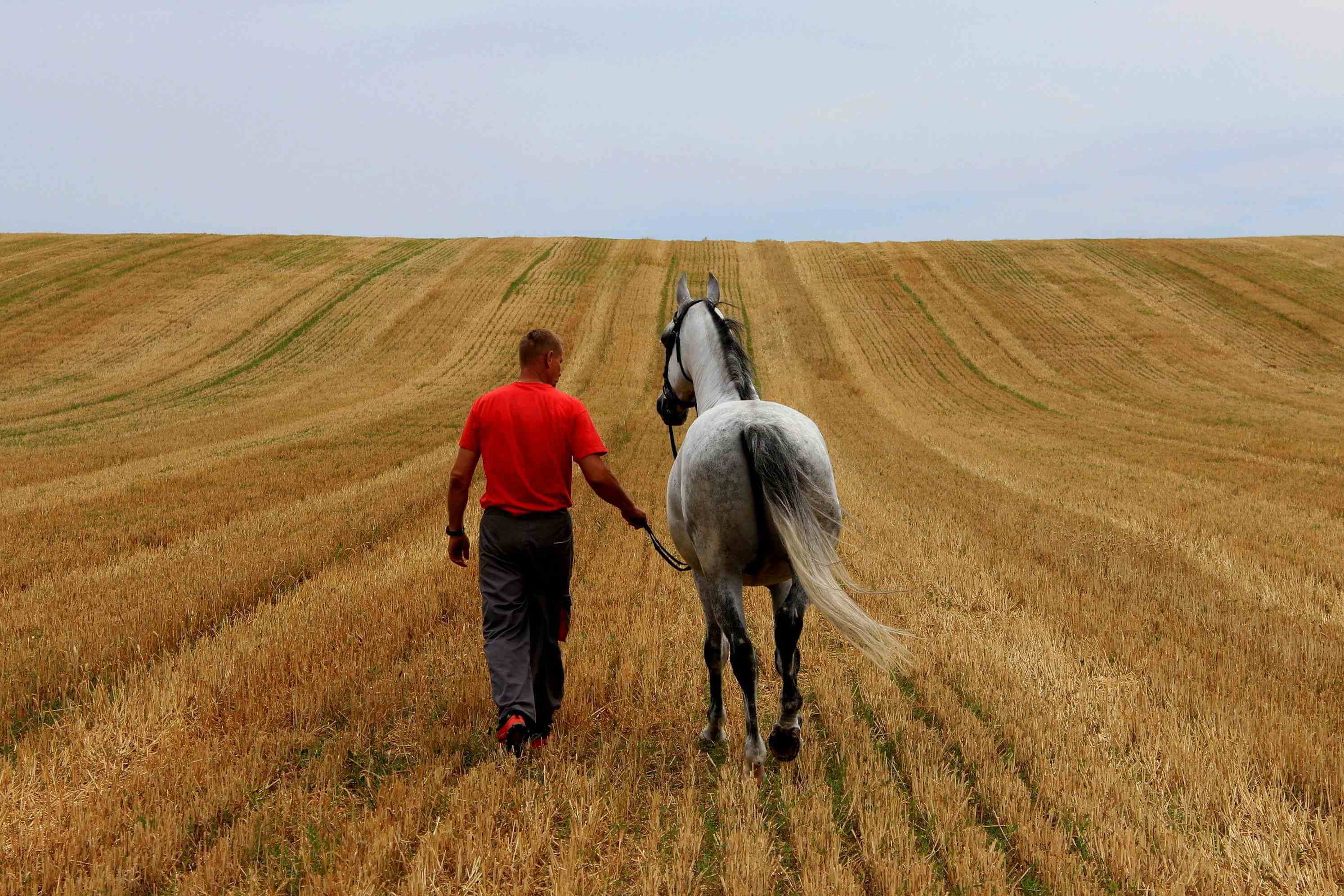 Croatian artistic photography by Silvija Butkovic
Croatian artistic photography by Silvija Butkovic
My name is Silvija Butkovic and I was born in 1964 in Osijek, Croatia. As a child, I lived on the island Lošinj. I returned to Slavonia when I entered University. I now live and work in Đakovo as manager of tourism an public relations at the State Stud Farm Đakovo (National Lipizzan Stud Farm Đakovo - Državna ergela Đakovo). Language and photography are my great loves. Lately, I've been making photo haigas, a Japanese combination of poetry and photography. The World Haiku Association recently awarded me the title Master of Haiga for my work. You can see some of it on their website www.worldhaiku.net/haiga. Lošinj and the heart of the Slavonian plain are a constant inspiration. I also adore horses and I love watching them through the camera. I'm a member of 'Photo-cinema Club Djakovo', 'Photo-Club Rijeka' and 'Matica Hrvatska'
Željko Car 'Spring'
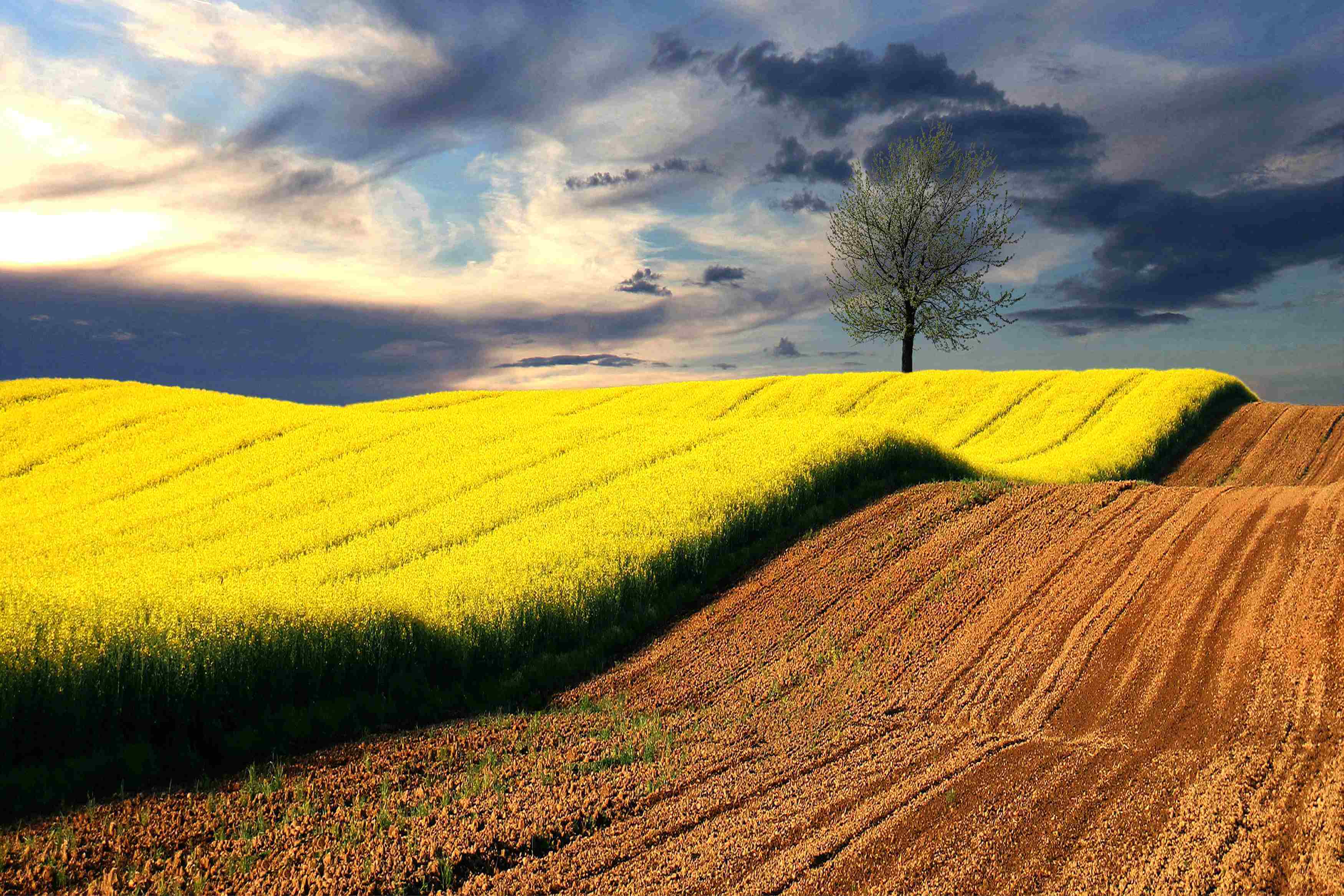 Croatian artistic photography by Željko Car
Croatian artistic photography by Željko Car
My name is Željko Car. I'm a lawyer by profession. I first published photos in newspapers (I was a correspondent for several). Since 1984 I've participated in exhibitions in many countries around the world. I have more than 300 awards and diplomas, and I received the honorary title of EFIAP. Two of my photos were selected for the 2021 Biennial of Colour Photography in France - 'Spring' and 'Snow on the river bank'. Both photos were taken near Đurđevac, the city where I live. With 'Spring' I wanted to show the beauty and ambient values of the area where I live. It was actually taken in the spring of 2000.
Aleksandar Tomulić 'Valencia 5'
 Croatian artistic photography by Aleksandar Tomulić
Croatian artistic photography by Aleksandar Tomulić
My name is Aleksandar Tomulić and I'm from Rijeka. I'm a semi-professional photographer. My main profession is IT. I've been taking photos since I was a kid. I was born in 1967. I became more seriously involved in photography in 2004. It's the magic of capturing an unrepeatable moment that fascinates me, and the feel for light and composition. I prefer street photography and seaside motifs, and I like to experiment with abstract images. Since 2013 I've volunteered to give classes and workshops. I'd like to pass on what I've learned about photography. I've had 15 one-man shows, participated in over 500 group shows and received over 320 awards. The Croatian Photo Association have selected my work ten times to represent Croatia at FIAP Biennales. I'm a member of 'Fotoklub Color' and 'Fotoklub Pag.' My photo 'Valencia 5' was taken, of course, in Valencia in the City of Art and Science. I took the shot in 2018. That new part of Valencia is the concept of famous architect Santiago Calatrava.
Ante Jaša 'Knot in Passage'
 Croatian artistic photography by Ante Jaša
Croatian artistic photography by Ante Jaša
My name is Ante Jaša. I was born on 19th October 1951 in Kukljica-Zadar. From the earliest days of my childhood, I played with a 'box camera' we had at home. My grandfather bought it in New York. He could never have known this would lead to his grandson having solo photography exhibitions in out home town. In 1970, my photography and writing started to be published in dailies (newspapers), weeklies and journals. By 1999 I'd progressed to be on the editorial board of the feuilleton “Mareta” (Wave) in the paper “Narodni list” - Zadar. I've exhibited my works at 418 collective exhibitions on every continent and have received numerous awards. I'm a member of the photo clubs 'Zagreb', 'Zadar' and 'Kornat' Kukljica. Sea and stone are the main motifs of my work. There's an inherent tension between them which I'm exploring. By taking photographs of both traditional and modern ways of life on the islands near Zadar, I show their natural ambience, the sea as well as on the mainland around Zadar. My photo 'Knot in Passage' was actually taken in 2015. The photo shows the entrance to the Art Gallery in Zadar. In the courtyard of the entrance was a modern metal sculpture. I put the sculpture in the foreground. The entrance is wide open and a passerby can be seen on the street. The sculpture seems to be inviting people to enter the gallery.
Ivan Nemet 'Field Geometry'
 Croatian artistic photography by Ivan Nemet
Croatian artistic photography by Ivan Nemet
My name is Ivan Nemet. I was born in Kloštar Podravski. I am retired and I spent my entire working life working on oil wells all over the world. Photography has been a hobby since my early days. I love all kinds of photos, but my favourite is landscape photography. Over the last few years, I’ve quite often been taking photos with a drone. Photographs from a bird's eye view are often interesting because they reveal compositions that cannot be seen from the ground. I've participated in various international photography exhibitions, one of them being this year's 29th Biennale in France. The Croatian jury selected two of my photos. They were both taken using a drone. The name of the first photo is 'Reed car'. It was made in the winter on the mountain Bilogora. The name of the other photo is 'Field Geometry'. The emphasis is on the lines created by the action. Both were made not far from where I live, in the continental part of Croatia, between the river Drava and the small mountain Bilogora. The name of this part of Croatia is Podravina.
For the latest travel info, bookmark our main travel info article, which is updated daily.
Read the Croatian Travel Update in your language - now available in 24 languages.
MPs Debate Candidates For Croatian Radio-Television's (HRT) Programming Council
ZAGREB, 3 March, 2021 - Parliament on Wednesday debated a draft list of candidates for Croatian Radio-Television's (HRT) Programming Council but opposition MPs, disgruntled that the HRT was not broadcasting the debate live, walked out of the chamber.
Parliament is expected to vote on the candidates who meet the requirements set by the parliamentary media committee on Friday.
During the debate before the walkout, Nino Raspudić of the opposition Bridge (Most) said the Programming Council "has no powers and serves nothing because no one listens to it, it has no role at all nor influence on the selection of anyone or anything."
"The HRT is in the service of the great leader and his clique on a caricature level," he said, adding that the reputation and relevance of the public broadcaster was being constantly degraded and that the HRT avoided covering serious topics.
Raspudić said the Programming Council was disempowered by amendments to the HRT Act adopted by the former SDP-led government, adding that the power was concentrated in the hands of the HRT director general and the HRT put under direct political control.
Željko Sačić of the opposition Croatian Sovereignists said the HRT did not have enough programmes for war veterans and criticised the Programming Council for failing to affirm the values in the Homeland War Declaration.
Marijana Puljak of opposition Centre suggested abolishing the licence fee and the Programming Council, saying that Croatia had high taxes which could be used to finance the HRT's work instead of additionally collecting HRK 1.3 billion annually from citizens. She added that there was no investigating journalism on the HRT.
Vesna Bedeković of the ruling HDZ denied that the Programming Council had no role or powers, saying it followed the implementation of programming principles and the HRT-government agreement.
She recalled that nine of the Council's 11 members were elected in parliament and two from the HRT staff, and dismissed complaints that there were no sufficient programmes for war veterans.
Miroslav Škoro To Run For Zagreb Mayor
ZAGREB, 3 March, 2021 - Leader of the Homeland Movement and Deputy Parliament Speaker Miroslav Škoro will run for mayor of Zagreb in the coming local election, sources from that party unofficially confirmed for Hina on Wednesday evening.
More information will be known in a few days time and Škoro will not be making any statements to the media today.
Ove the past few days Škoro has made vague statements about his candidacy. On Saturday he said that everyone in the Homeland Movement is in the game when it comes to running for Zagreb mayor, including himself.
"Each member of the Homeland Movement has to be prepared to be in the game and that's the principle we function by," Škoro said then.
Attending late Mayor Milan Bandić's funeral today, Škoro said that the candidate from his party would be announced in a few days' time.
Croatian MEP Tonino Picula: Croatia Not interfering In Bosnia's Affairs, Expects Greater EU Involvement
ZAGREB, 3 March, 2021 - The Croatian member of the Socialists and Democrats group in the European Parliament, Tonino Picula, on Wednesday dismissed claims that Croatia was interfering in Bosnia and Herzegovina's internal affairs, saying that Croatia had obligations under the Dayton peace agreement.
Speaking in an interview with the Dnevnik news website based in the southern Bosnia and Herzegovina city of Mostar, Picula said that Croatia was accused, almost on a daily basis, of interfering in Bosnia and Herzegovina's internal affairs. He recalled that Croatia was a signatory to the Dayton agreement that ended the 1992-1995 war in the country and had an obligation to ensure that the agreement was honoured.
"Unfortunately, we often see political structures in Bosnia and Herzegovina using Croatia to achieve their political points and divert attention from their own problems," the Croatian MEP said. He, however, added that Croatian institutions and officials should exercise restraint in their communications with Bosnia and Herzegovina.
"In its relationship with the Bosnia and Herzegovina, Croatia should maintain a positive interest with political restraint, taking care that it promotes what will encourage Bosnia and Herzegovina to continue on its EU path," Picula said.
He said that the EU should be more dedicated to the Western Balkans and Bosnia and Herzegovina. "As the foreign policy coordinator of the Socialists and Democrats group in the European Parliament, I have continually pointed out the need for the Union and its external policy to win recognition in its nearest neighbourhood."
Picula expressed an expectation that Bosnian politicians would agree on changes to electoral legislation that would satisfy both individual and collective rights, which is important for the country's further journey towards EU membership. He stressed that this would include amending the Dayton agreement.
"The existing arrangements under the Dayton agreement are obviously preventing the country's progress, but the international community will not support any solution that deviates from the principle of Bosnia and Herzegovina as a single country," the Croatian MEP said.
Almost HRK 7 Billion Paid To Farmers In Support In 2020
ZAGREB, 3 March, 2021 - Last year the Agriculture Ministry paid a total of HRK 6.99 billion in support for farmers, which is 20% or 1.16 billion more than in 2019.
In a press release on Wednesday, the ministry said that support paid in 2020 from EU finds amounted to HRK 5.5 billion which is 23% or 1.04 billion more than 2019 and the largest amount of EU funds paid out ever.
In 2020, just before Croatia's presidency of the Council of the EU ended, a regulation on support for rural development from the European Agriculture Fund for Rural Development was amended, enabling Measure 21 -"'Extraordinary temporary support for farmers and SMEs particularly affected by the crisis caused by the disease COVID-19," under which Croatian farmers were allocated an additional HRK 360 million.
Thanks partially to COVID measures, this year's wine envelope has the greatest absorption ever, by as much as 94% and about HRK 76 million was invested in the wine sector in 2020, the ministry said in its press release.
Amendments to the EU regulation on the European Maritime and Fisheries Fund, aimed at relieving the consequences of the COVID-19 pandemic, enabled measures amounting to HRK 180 million.
At the same time, HRK 3.04 billion was paid in direct payments to farmers last year, or HRK 121.34 million more than in 2019.
The ministry noted that money from the state budget is earmarked to finance national support programmes and in that regard HRK1.49 billion was paid out, which is 9% or HRK 121.47 million more than in 2019.
Bosnian Companies Donate Building Material To Banovina
ZAGREB, 3 March, 2021 - The Bosnian Federation Chamber of Commerce, acting in cooperation with the Croatian Chamber of Commerce (HGK), has organised the delivery of eight trucks full of building material donated by Bosnian enterprises for earthquake victims in the Banovina region of central Croatia, the HGK said on Wednesday.
The donation includes cement, bricks, concrete blocks and roof tiles, which will be distributed to Sisak, Petrinja, Glina and Hrvatska Kostajnica.
The Director of the Federation Chamber of Commerce, Marko Šantić, said that they had collaborated with the HGK on many projects.
"We look upon the HGK and Croatia as an EU member as our older brothers who are helping Bosnia and Herzegovina to overcome its economic problems and join the European Union. This was an opportunity for us to reciprocate," Šantić said, thanking all Bosnian companies that took part in the donation.
Speaking on behalf of the four towns, the Mayor of Petrinja, Darinko Dumbović, thanked the Bosnian companies for the donation.



